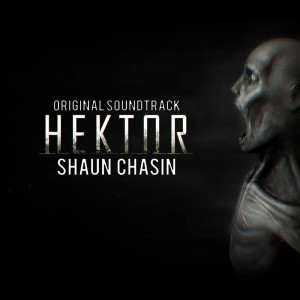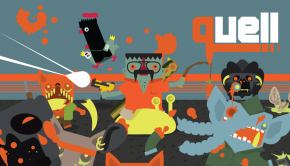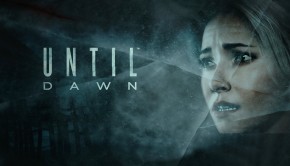Hektor Original Soundtrack
 |
Album Title: Hektor Original Soundtrack |
| Record Label: Meridian4 |
|
| Catalog No.: N/A |
|
| Release Date: March 13, 2015 |
|
| Purchase: Download at Steam |
Overview
Psychological horror game Hektor comes with a score by Shaun Chasin and a performance by the impressive Slovak Radio Symphony Orchestra. The album, like the game, is short, clocking in around 40 minutes, but the content is carefully selected from a much wider range of music played during the game. The music of Hektor adds drastically to the terror of the game which is, due to the lack of reliable vision the player experiences, vitally impacted by any and all sound. Chasin uses this to blend sound and music together in creating the score, which meshes very well with the insane and terrifying world of Hektor.
Body
The opening track, “Is This Real?”, immediately takes advantage of the full set of strings to open with a dark melody, progressing only a couple of notes a time, and supported by shifting, disconcerting chords. The piece straddles the line between beautiful and eerie, drawing on harsh, melodic dissonance before the piece ends with a rapid descent into synth sounds. The opening reflects the nature of the entire album; the following track, “History,” begins with a gorgeous slow-moving string descent, from a pure, high B-flat all the way down to an alto melody, without ever really losing a single note in the piece. The resulting sound is an almost watercolor-like effect, like the pedal being held down on the piano. The piece is radiant but short, and too soon the strings crescendo into an abrupt, mechanical close, ending the forty-second gem of a track.
“The Offices” is the longest track on the album, and creates what is perhaps the most representative track of in-game setting. The tracks opens with windy sounds, descending atonal strings, and extremely gentle synth percussion combining to create an atmospheric effect. As the piece progresses, it becomes slightly more instrumental, with strings cueing in at about 1:40 with a somber melody. Chasin utilizes instruments outside of their conventional norms for a more effect-oriented approach. A single flute adds to the windy opening, and trumpets add a simultaneously muted and blaring ripple in the score. Before the piece ends, the theme from “Is This Real?” returns momentarily on low strings, laced irregular percussion, and the piece crashes to a close through a horrendous cacophony of strings.
One strangely tranquil song, “Stop the Water,” uses the same instrumental and synth techniques but for a track that’s far more peaceful than the others we’ve seen so far and bell-like sounds. Under the gentle exterior, the synth throws in regular croaking or crackling to underline the game’s horror genre despite the surface-level tranquility, marked by gentle bell-like sounds and chimes. On the other hand, “Run and Hide” is the for me the most unsettling track of the album, opening with a musical jump-scare involving unusual string-clashing percussion techniques and horrendously high violins. While Chasin does establish a more conventional pulse-racing pattern in the lower strings through straightforward eighth notes and diatonic patterns, the unnaturally high notes and percussion keep the piece from being a straightforward chase scene, and instead maintain a jittery, frenetic pace.
The album continues to become jarring and nervewracking. “The Infirmary” opens with a few continuous atmospheric sounds finally broken by strings about two minutes into the piece. Like “Stop the Water,” there are moments of beauty in this piece — while they’re quickly masked by the more ominous sounds of low percussion, strings, and synth, the moments are still there. The final two pieces bring in the Slovak Radio Symphony Orchestra with more force. “Time Out” is a 1:17 cello solo that, like many of the previous pieces on the album, maps the boundary between gorgeous and horrific. The solo is just that: other than some mild effect sounds, neither harmony nor bassline of any kind accompany the cello. The melody is not the main theme, but is perhaps a loose countermelody to the theme, utilizing more of the scale than the original. The final track, however, embraces the main theme with the full string orchestra, beginning slowly and eerily but as the piece progresses, more and more instruments gradually enter. Each section receives its own solo instrument, if momentarily, and the score becomes — perhaps for the first time since the first track — a resonant, tender orchestral work. Of course, Hektor is all about psychological torment, and the piece does not stay this way for long, quickly giving way to the screeching high strings and dark percussion alongside low strings, before finally ending in an unexpected whirlwind of rising strings.
Summary
Hektor is written to create an atmosphere, and it does — but not at the cost of a thematic content. Chasin constructed the album as a sampling of music from the score, arranged in chronological order of the game, but not necessarily what a player would experience upon a single play through. The resulting album is fantastically creepy and unsettling, which makes for an interesting stand-alone dilemma — as effective as the score is in heightening the terror aspect of Hektor, there is really a limit as to how much enjoyment the listener can feel listening to it outside the game. In other words, listening to Hektor late into the night while working would be petrifying; however, when playing Hektor, there’s no score I’d rather have accompanying me. While it certainly functions best in-game, the sound makes for an interesting listening experience on its own; certainly, Chasin has unquestionable ability in orchestrating gorgeous string gems throughout the chilling score.
Do you agree with the review and score? Let us know in the comments below!
3.5
Posted on May 5, 2015 by Emily McMillan. Last modified on May 8, 2015.














